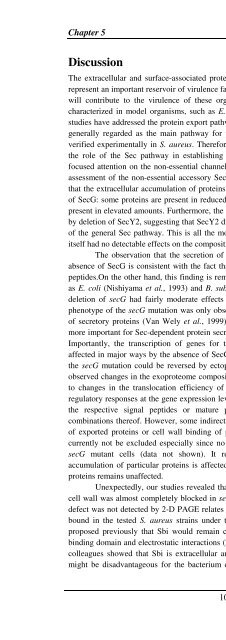The Staphylococcus aureus secretome - TI Pharma
The Staphylococcus aureus secretome - TI Pharma
The Staphylococcus aureus secretome - TI Pharma
Create successful ePaper yourself
Turn your PDF publications into a flip-book with our unique Google optimized e-Paper software.
Chapter 5<br />
Discussion<br />
<strong>The</strong> extracellular and surface-associated proteins of bacterial pathogens, such as S. <strong>aureus</strong>,<br />
represent an important reservoir of virulence factors. Accordingly, protein export mechanisms<br />
will contribute to the virulence of these organisms. While protein export has been well<br />
characterized in model organisms, such as E. coli and B. subtilis, relatively few functional<br />
studies have addressed the protein export pathways of S. <strong>aureus</strong>. Notably, the Sec pathway is<br />
generally regarded as the main pathway for protein export but, to date, this has not been<br />
verified experimentally in S. <strong>aureus</strong>. <strong>The</strong>refore, the present studies were aimed at assessing<br />
the role of the Sec pathway in establishing the extracellular proteome of S. <strong>aureus</strong>. We<br />
focused attention on the non-essential channel component SecG as this allowed a facile coassessment<br />
of the non-essential accessory Sec channel component SecY2. Our results show<br />
that the extracellular accumulation of proteins is affected to different extents by the absence<br />
of SecG: some proteins are present in reduced amounts, some are not affected and some are<br />
present in elevated amounts. Furthermore, the effects of the absence of SecG are exacerbated<br />
by deletion of SecY2, suggesting that SecY2 directly or indirectly influences the functionality<br />
of the general Sec pathway. This is all the more remarkable since the absence of SecY2 by<br />
itself had no detectable effects on the composition of the extracellular proteome of S. <strong>aureus</strong>.<br />
<strong>The</strong> observation that the secretion of a wide range of proteins was affected by the<br />
absence of SecG is consistent with the fact that all of these proteins contain Sec-type signal<br />
peptides.On the other hand, this finding is remarkable since studies in other organisms, such<br />
as E. coli (Nishiyama et al., 1993) and B. subtilis (Van Wely et al., 1999) have shown that<br />
deletion of secG had fairly moderate effects on protein secretion in vivo. In B. subtilis, a<br />
phenotype of the secG mutation was only observed under conditions of high overproduction<br />
of secretory proteins (Van Wely et al., 1999). Clearly, our present data show that SecG is<br />
more important for Sec-dependent protein secretion in S. <strong>aureus</strong> than in B. subtilis or E. coli.<br />
Importantly, the transcription of genes for three proteins (Geh, Hlb and Spa) that were<br />
affected in major ways by the absence of SecG was not changed, and all observed effects of<br />
the secG mutation could be reversed by ectopic expression of secG. This suggests that the<br />
observed changes in the exoproteome composition of the S. <strong>aureus</strong> secG mutant strain relate<br />
to changes in the translocation efficiency of proteins through the Sec channel rather than<br />
regulatory responses at the gene expression level. This could be due to altered recognition of<br />
the respective signal peptides or mature proteins by the SecG-less Sec channel, or<br />
combinations thereof. However, some indirect effects, for example at the level of translation<br />
of exported proteins or cell wall binding of proteins like IsaA, LytM, Spa and SsaA, can<br />
currently not be excluded especially since no proteins were found to accumulate inside the<br />
secG mutant cells (data not shown). It remains to be shown why the extracellular<br />
accumulation of particular proteins is affected by the absence of SecG, while that of other<br />
proteins remains unaffected.<br />
Unexpectedly, our studies revealed that export of the IgG-binding protein Sbi to the<br />
cell wall was almost completely blocked in secG mutant strains. <strong>The</strong> reason why this export<br />
defect was not detected by 2-D PAGE relates to the fact that Sbi is predominantly cell wallbound<br />
in the tested S. <strong>aureus</strong> strains under the experimental conditions used. It has been<br />
proposed previously that Sbi would remain cell wall-attached through a proline-rich wallbinding<br />
domain and electrostatic interactions (Zhang et al., 1998). Nevertheless, Burman and<br />
colleagues showed that Sbi is extracellular and they suggested that cell surface-bound Sbi<br />
might be disadvantageous for the bacterium due to its role in modulating the complement<br />
106













